Last updated: August 21, 2025
Article
2025 Excellence in Volunteerism Awards
The Excellence in Volunteerism Awards are given annually to National Park Service volunteers who demonstrate exceptional dedication to their park and community. These recipients embody the values of service, engagement, and stewardship fundamental to our national parks.
Recipients by Category
-
Impact Award: Youth and Young Adult | Adult | Team
Innovation Award
This award recognizes a volunteer initiative within a park or program that has demonstrated significant innovation or creativity in meeting a park/program goal or need through volunteerism.
- Duration:
- 1 minute, 39 seconds
The more than 4,300 volunteers who contributed to the Woolsey Fire Recovery Camera Project at Santa Monica Mountains National Recreation are the recipients of the 2025 Excellence in Volunteerism Innovation Award.
National Recipient
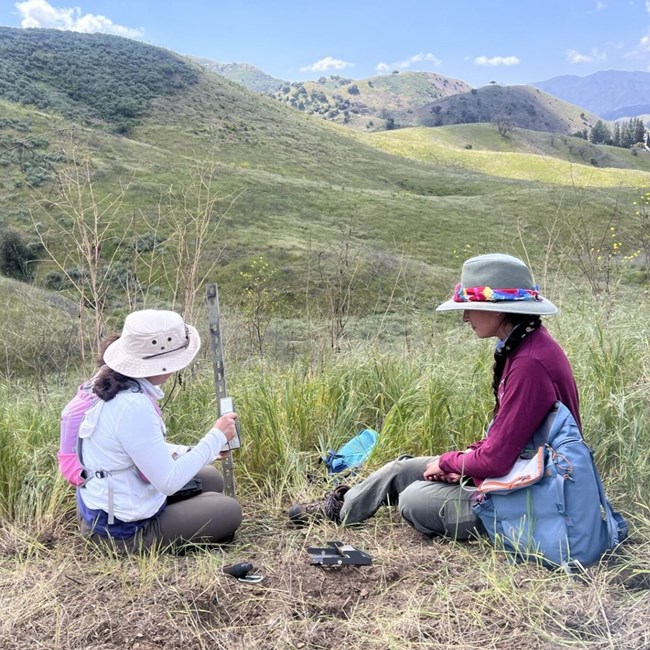
Woolsey Fire Recovery Camera Project
Santa Monica Mountains National Recreation Area
Region 8, 9, 10, 12 – Pacific West
Following the devastating 2018 Woolsey Fire, volunteers at Santa Monica Mountains National Recreation Area stepped up to support one of the most ambitious post-wildfire wildlife monitoring efforts in the region. Through the Woolsey Fire Recovery Camera Project, over 4,300 volunteers have contributed more than 12,500 hours since 2019, helping researchers document wildlife recovery across a fire-impacted landscape of over 96,000 acres.
Volunteers have supported this project in the field by installing and rotating wildlife cameras and online through Zooniverse, classifying over one million images of local fauna from the camera traps set up in fire-affected areas. Their work has been vital in understanding how species return to fire-affected habitats and in building long-term data sets that inform park management.
The team’s efforts have also powered impactful public programming, including a traveling photo exhibit that reached over 6,000 visitors and presentations that have drawn hundreds more. These initiatives connect local communities to their nearby park and demonstrate the power of citizen science in conservation. With continued wildfire threats on the horizon, this dedicated volunteer team is helping illuminate the path toward resilience, recovery, and stewardship.
Regional Recipients

Kristen Kircher
Delaware Water Gap National Recreation Area
Region 1 – Northeast
Kristen Kircher is a dedicated Park Ambassador at Delaware Water Gap National Recreation Area. She contributed over 190 volunteer hours in fiscal year 2024 alone, primarily at the Dingmans Falls Visitor Center, where she welcomed more than 760 visitors—many of them first-time visitors to the park.
Kristen goes above and beyond her visitor services duties, bringing creativity, passion, and ecological knowledge to every interaction. Almost every summer weekend, she could be found greeting guests, offering trail guidance, and interpreting the park’s flora and fauna. On her own initiative, Kristen created an engaging pop-up education table featuring her personal collection of pelts, turtle shells, bones, and more—inviting hands-on learning and sparking curiosity in visitors of all ages.
Kristen’s creativity shines through in everything she does. At the park’s 2024 solar eclipse event, she brought handmade crochet models—a solar eclipse and a moon phase scarf—to help interpret complex astronomical concepts in an accessible, eye-catching way. Whether she’s inspiring young learners, picking up litter on trails, or educating visitors about the value of the park’s natural resources, Kristen embodies the spirit and mission of the National Park Service.

Fossil Expedition Team
Mammoth Cave National Park
Region 1, 2, 4 – Southeast
The Fossil Expedition Team at Mammoth Cave National Park has made extraordinary contributions to paleontological research and public engagement. Composed of dedicated volunteers, including current and former park staff, the team has discovered over 700 shark fossil specimens. The specimens represent 75 species, including 4 newly identified species, and documented more than 50 fossil localities.
Collaborating with scientists and the National Park Service Paleontology Program, the team conducts challenging fieldwork in caves and surface areas to locate, excavate, and preserve fossils. Their efforts have dramatically expanded the park’s fossil inventory and contributed to scientific publications.
Beyond the field, the team brings paleontology to life for visitors through hands-on public events like National Fossil Day. Their outreach—including fossil displays, expert talks, and educational activities—has inspired new volunteers and engaged audiences worldwide, making them outstanding ambassadors for science and stewardship.
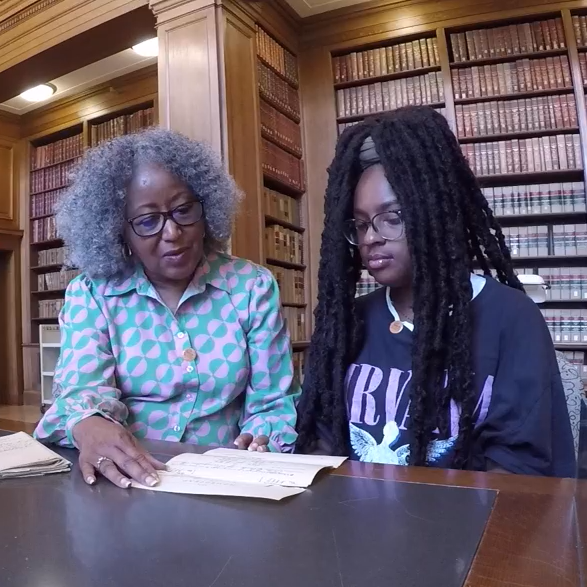
Virtual Volunteer Team
Homestead National Historical Park
Region 3, 4, 5 – Midwest
Homestead National Historical Park’s Virtual Volunteer Team has transformed how remote audiences connect with the park’s mission. This innovative group of over 300 volunteers from across the country supports projects ranging from transcribing homesteading case files to creating social media content and building outreach databases, making meaningful contributions without ever setting foot in Nebraska.
In 2024, the team transcribed over 80 case files, each 15 to 30 pages long, enhancing accessibility by turning historical documents into screen-reader-compatible formats. Volunteers also captured and submitted landscape photography from the 30 homesteading states for the park’s #HomesteadingState campaign, and others drafted creative content for the park's growing digital presence.
The program has eliminated geographic barriers, fostered community partnerships, and opened the door for accredited internships and unique collaborations, such as uncovering and sharing the stories of Black homesteaders. Homestead's Virtual Volunteer Team exemplifies how flexible volunteer opportunities can preserve history, inspire learning, and expand the reach of the National Park Service.
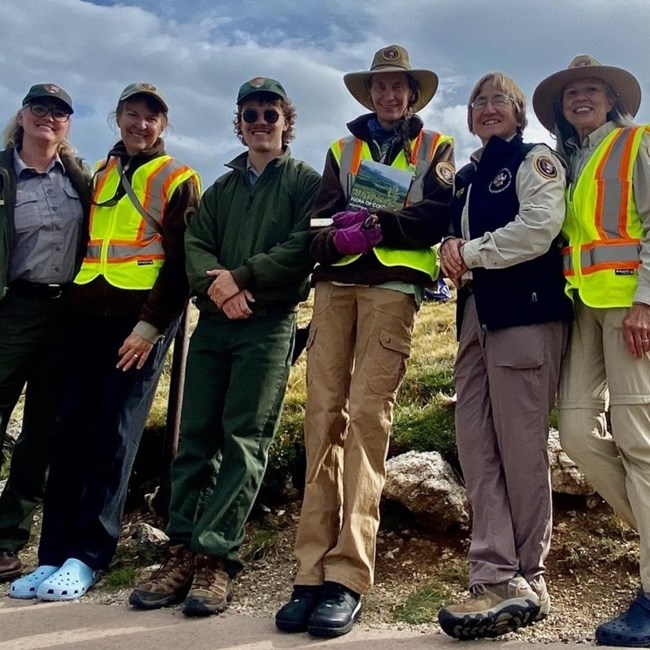
Alpine Bloom Crew
Rocky Mountain National Park
Region 6, 7, 8 – Intermountain
The Alpine Bloom Crew at Rocky Mountain National Park is a newly formed team of expert volunteers dedicated to protecting and studying the park’s iconic alpine tundra. In their inaugural 2024 season, the crew began collecting phenological data at a historic tundra research site, contributing to long-term monitoring and future community science opportunities.
With over 100 combined years of experience, the crew includes former rangers, professors, photographers, and authors. While conducting fieldwork along the heavily visited Trail Ridge Road, crew members also engage with visitors, educating them about tundra ecology and inspiring stewardship.
Backed by Rocky Mountain Conservancy, the Alpine Bloom Crew is helping shape an innovative, sustainable model for public engagement and scientific research in national parks—ensuring the protection of the tundra for generations to come.
Impact Award: Youth and Young Adult Category
This award recognizes a single individual age 30 or under (non-Veteran), 35 or under (for Veterans), who has made a meaningful impact for their park or program. Over 38,000 volunteers under the age of 25 volunteered in National Park Service sites in 2024.
- Duration:
- 1 minute, 15 seconds
Anthony Kousharian, a volunteer at Muir Woods National Monument, is the recipient of the 2025 Excellence in Volunteerism Impact Award - Youth and Young Adult.
National Recipient
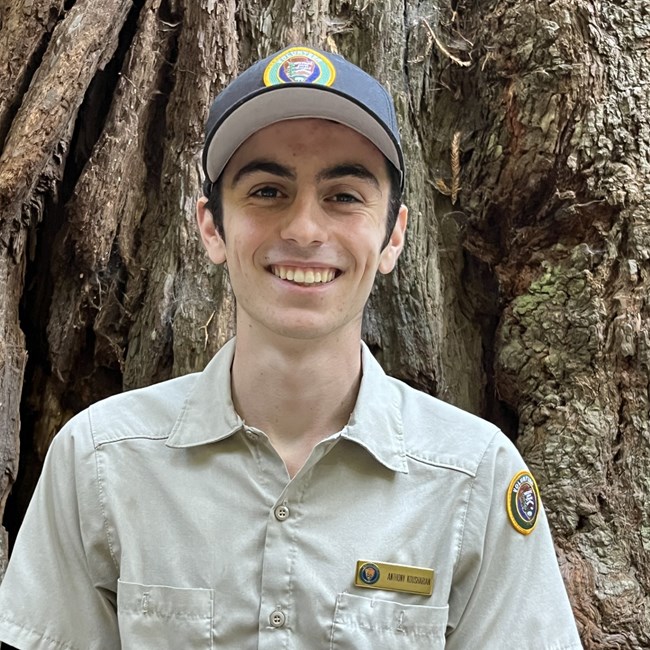
Anthony Kousharian
Muir Woods National Monument
Region 8, 9, 10, 12 – Pacific West
Anthony Kousharian, a high school student, has made significant contributions to the park through his volunteer work. He enhanced the “Welcome to the Woods” interpretive talk by simplifying complex scientific concepts, making them accessible to visitors of all ages. His research on redwood resilience and cultural narratives enriched the experience, increasing engagement and sparking interest in park history and sustainability.
During his Enterprise for Youth internship, Anthony also helped create a video on the park’s sustainability efforts, which reached new online audiences and supported the park’s climate action initiatives. He consistently goes beyond expectations by integrating Native American and women’s perspectives into his talks.
Anthony’s engaging presentations and dedication to sharing the park’s story have inspired curiosity and led to greater visitor engagement. He consistently supports park operations, covering the visitor center desk and leading interpretive talks, especially during peak hours. His work fosters a sense of shared stewardship and serves as an example to other young volunteers, encouraging them to get involved in conservation efforts.
Regional Recipients

Avery Ohliger
Upper Delaware Scenic & Recreational River
Region 1 – Northeast
In summer 2024, Avery Ohliger brought innovation, technical expertise, and leadership to Upper Delaware Scenic and Recreational River by revitalizing the park’s oral history project. Tasked with preserving interviews dating back over forty years, Avery discovered many recordings had degraded or become inaccessible. Drawing on his background in audio engineering, he enhanced audio quality and reconverted cassette recordings into stable, multi-format digital files—rescuing invaluable voices from the region’s past.
Avery revolutionized the transcription process by integrating AI tools to dramatically reduce time and effort, making it possible for volunteers to generate accurate transcriptions in minutes rather than hours. His methods laid the groundwork for an accessible, searchable online oral history archive, and his coordination of biweekly meetings helped train and support a growing team of volunteers across the country.
Through public presentations and local partnerships, Avery’s work sparked wider community involvement, inspired new oral history contributions, and caught the attention of regional historical societies. His impact will resonate far beyond the summer, ensuring the cultural legacy of the Upper Delaware Valley is preserved and shared for generations to come.

Thomas Jones
Moores Creek National Battlefield
Region 1, 2, 4 – Southeast
Thomas Jones has been an integral part of the Moore Creek Stories Beyond the Battlefield’s Toys and Games program for several years. He joined the initiative alongside his mother, Amy, and older sister, Taylor, when he was just nine years old. Over the years, Thomas has taken the lead in the program, becoming one of the park’s key subject matter experts. His deep knowledge of colonial toys and games and his enthusiasm for sharing them with the public have made him a standout interpreter, particularly with local public and homeschool groups.
In 2023, Thomas’s role expanded as he began leading colonial toy demonstrations for visiting students. Encouraging participation, he turned historical play into interactive, memorable memories—resonating particularly with peers his own age.
Thomas’s dedication to the National Park Service’s mission and his work in the Toys and Games program have elevated Moore Creek’s educational offerings. His presentations have become a favorite among local schools, with many fourth grade students citing them as one of the highlights of their visit, just behind the musket demonstrations. Through his efforts, Thomas has brought new life to the colonial toys and games program, creating lasting memories for visitors and reinforcing the park’s commitment to education and engagement.
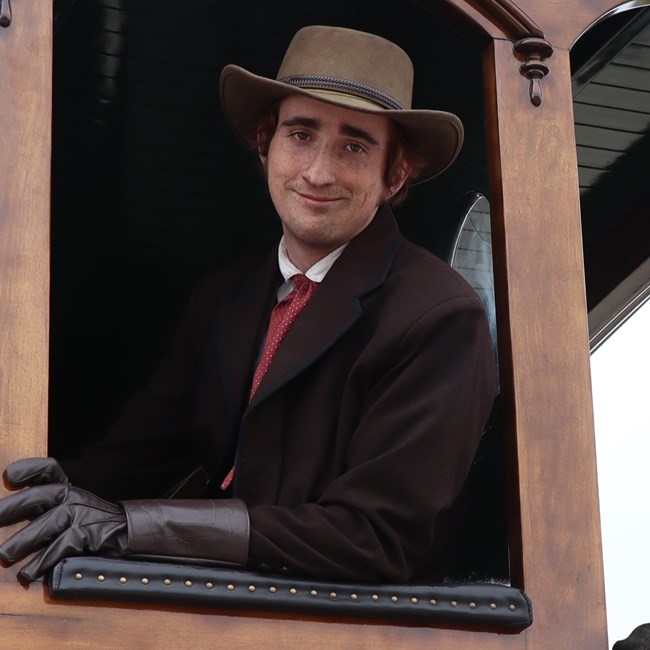
Chance Davis
Golden Spike National Historical Park
Region 6, 7, 8 – Intermountain
Chance Davis has been a dedicated volunteer at Golden Spike National Historical Park (NHP) since 2021, serving as a locomotive fireman. At just 18, Chance took on this challenging role and quickly became an integral part of the locomotive crew, mastering the skills needed to operate the park's two replica steam locomotives. In addition to firing the locomotives, Chance engages with visitors, sharing his knowledge of the transcontinental railroad and answering questions and making the experience more interactive and meaningful.
During the off-season, Chance helps maintain the locomotives, performing tasks such as polishing brass, sanding, repainting surfaces, and inspecting parts. His attention to detail ensures the locomotives are ready for their next season of operation. Chance’s visibility as a young volunteer has also led to greater engagement with younger visitors and has even inspired new recruits for the park's volunteer program.
Beyond his work as a fireman, Chance is also an avid photographer, contributing stunning images of the park to social media and outreach efforts, including one featured on the 2025 Golden Spike NHP Annual Pass. Through his dedication to both the technical and educational aspects of his role, Chance has made a lasting impact on the park’s preservation and its connection to the community.
Impact Award: Adult Category
This award recognizes a single individual over age 30 (non-Veterans) or over age 35 (for Veterans) who has made a meaningful impact for their park or program.
- Duration:
- 1 minute, 8 seconds
Edward Day, a volunteer at San Antonio Missions National Historical Park, is the recipient of the 2025 Excellence in Volunteerism Impact Award - Adult.
National Recipient
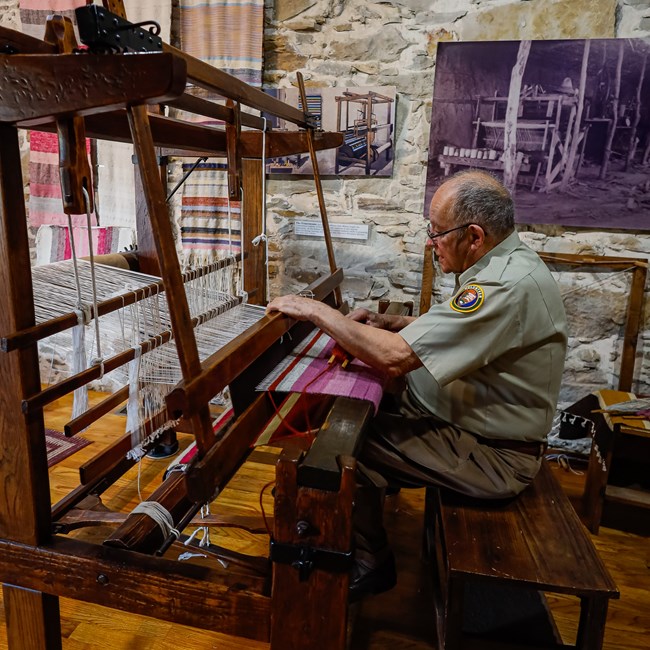
Edward Day
San Antonio Missions National Historical Park
Region 6, 7, 8 – Intermountain
For nearly a decade, Edward Day has been the driving force behind the weaving demonstration program at Mission Espada. Through his expertise in hand-dyeing, spinning, and weaving, Ed has reconnected thousands of visitors with the traditional textile arts of South Texas. Using materials like cochineal insects and pecans, Ed creates historically accurate colors while teaching both staff and visitors about the cultural and ecological roots of these practices. His engaging, hands-on programs—like cochineal painting—bridge history and science in ways that resonate with audiences of all ages.Ed’s work has inspired deeper community partnerships, from a collaborative loom project with the Witte Museum to ongoing support from the San Antonio Handweaver’s Guild. Thanks to Ed, Mission Espada has become a hub of cultural connection, where guests from around the world find common ground through the shared tradition of weaving. His impact is lasting, visible, and deeply felt—threading together the past, present, and future of the park.
Regional Recipients

Elizabeth Sullock
Washington-Rochambeau Revolutionary Route
Region 1 – Northeast
Elizabeth Sullock has made significant contributions to the Washington-Rochambeau National Historic Trail through her exceptional leadership and dedication as a volunteer. She played a pivotal role in organizing the French in Newport program, where she coordinated over 100 reenactors and attracted a remarkable 2,800 visitors. Elizabeth’s attention to detail in ensuring the historical accuracy of the reenactments, while also making them accessible and engaging, brought the Revolutionary War story to life in a way that deepened visitors' understanding of the period and its significance.
Beyond her work with reenactors, Elizabeth organized a youth-focused historical tea party, providing an interactive and educational experience for children to explore the trail's rich history. This event not only helped young visitors connect with the past, but also fostered a sense of curiosity and excitement about historical preservation. Additionally, Elizabeth has been involved in the planning efforts for the America 250 Commemoration, ensuring that the Washington-Rochambeau Trail’s programs remain relevant and engaging as the nation looks ahead to future celebrations of its history.
Through her dedication to education, historical preservation, and community engagement, Elizabeth has significantly enhanced the trail’s programs and the experiences of its visitors. Her leadership inspires those around her, encouraging others to contribute to the preservation and celebration of American history. Elizabeth’s work continues to inspire others to get involved in preserving and sharing the stories of our nation's past.
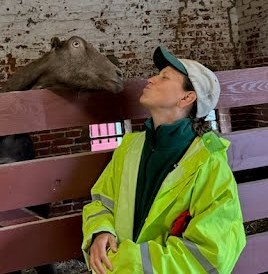
Kimberly Brill
National Capital Parks-East (Fort Washington Park)
Region 1 – National Capital
Kimberly Brill has been an invaluable volunteer with the National Park Service since 2021, dedicating her time to Oxon Hill Farm and Fort Washington Park. At Oxon Hill, she has supported both the animal care and maintenance teams and expanded her role to assist with school programs and special events. She has played an integral part in the farm’s spring school programming, helping with daily groups of 25-50 children in grades K-6.
In 2024, Kimberly began volunteering at Fort Washington Park, where she has led monthly cleanups and artillery demonstrations, engaging with up to 75 visitors at a time. She created a successful scavenger hunt based on a local historical story, which attracted children and adults alike, and is working to make the activity more accessible by translating it into Spanish. Kimberly also promotes the park’s programs at local military bases, community centers, and through online groups, successfully recruiting volunteers for cleanup projects and park initiatives.
Her outreach efforts have helped recruit volunteers for monthly cleanups and special events, including large programs like the Egg-stravaganza and Farm Fall Fest. Kimberly’s commitment extends to on-site interpretive tours at Fort Washington, where she educates visitors about the site’s history while fostering continued community engagement. Through her work, Kimberly ensures the preservation of the parks while inspiring others to get involved in conservation efforts. She earned nearly 1000 volunteer hours in fiscal year 2024 and continues to be a driving force in the success of National Capital Parks-East.

Larry Muir
Fort Pulaski National Monument / Grand Teton National Park
Region 1, 2, 4 – Southeast
Larry Muir has dedicated more than 20,000 volunteer hours over 24 years, making lasting contributions to both Fort Pulaski National Monument and Grand Teton National Park. At Fort Pulaski, Larry’s expertise in artillery maintenance has been central to preserving the park’s historic cannon and carriages. Each year, he identifies and treats the most vulnerable pieces, removing rust, applying protective coatings, and improving methods for long-term care. His work has informed the park’s standard operating procedures and inspired community members, from Boy Scouts to conservation corps participants, to join him in caring for this vital history.
Known affectionately as the “Mayor of the Moose-Wilson," Larry educates thousands of visitors at Grand Teton each year. His steady presence ensures safe wildlife viewing and creates lasting memories for visitors and Junior Rangers alike.
Larry’s combination of technical skill, humility, and people-centered service sets a gold standard for volunteerism. From preserving historic artillery on the Georgia coast to protecting wildlife in the Tetons, he brings passion, precision, and heart to everything he does. His legacy is felt not just in the resources he helps protect, but in the countless visitors and volunteers he inspires along the way.

Dan Dueweke
North Country National Scenic Trail
Region 3, 4, 5 – Midwest
Dan Dueweke has been a dedicated steward of national scenic trails since 1996. He first volunteered with the Appalachian Trail and then with the North Country National Scenic Trail since 2019. As a member of the Jordan Valley 45° Chapter, Dan leads trail projects, mentors volunteers, and fosters relationships that elevate public awareness and engagement. As the trail adopter coordinator, he supports 15 trail sections across 80 miles, all while maintaining his own 5-mile stretch. A trained chainsaw and crosscut sawyer, Dan leads sawing operations and teaches tool safety and technique to new volunteers.
Dan's leadership was critical in 2022 when he traveled 625 miles to help clear tornado-damaged trail in Minnesota’s Superior National Forest. Working alongside the U.S. Forest Service, he helped remove more than 500 trees from nearly a mile of wilderness trail and trained 4 new sawyers. Closer to home, he has enhanced the trail experience by building steps and puncheon structures, installing interpretive signage, and creating innovative systems to streamline volunteer work—all while ensuring environmental compliance and logistical efficiency.
Beyond trail work, Dan is a passionate advocate and storyteller. Through presentations, podcasts, and major outdoor events like the Quiet Adventures Symposium and Canoecopia, he inspires others to explore and protect the Trail. His efforts connect seasoned hikers and newcomers alike, helping them feel part of the broader trail community. Whether he’s in the field with a saw or behind a microphone sharing stories, Dan is helping extend the benefits of public lands to all.
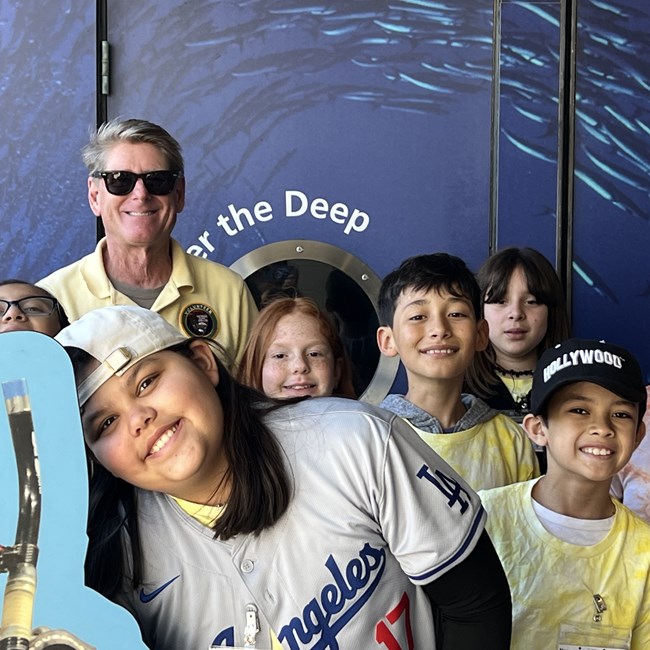
Steve West
Channel Islands National Park
Region 8, 9, 10, 12 – Pacific West
Steve brings 37 years of educational experience to Channel Islands National Park as a retired high school science teacher. Starting with habitat restoration and native plant garden work, Steve quickly became an indispensable part of the education team. He engages students on field trips with enthusiasm (and even guitar music) while designing meaningful, curriculum-based programs that connect classroom learning to real-world conservation.
Steve helped reimagine the park’s service learning program to be more relevant, especially for first-generation and college-bound students. His work has inspired students to see restoration ecology not just as a topic, but as a possible future. He also co-developed the Channel Islands Educator Corps, empowering teachers to weave park resources into their own classrooms and build community with each other.
Thanks to his thoughtful, wide-reaching contributions, Steve’s impact continues to grow, shaping how students and educators connect with the park for years to come.
Impact Award: Team Category
This award recognizes multiple Volunteers-In-Parks (a group, couple, family, or collective of any age range) who have consistently volunteered and collaborated together and may have worked on a variety of projects or may have had a more singular focus.
- Duration:
- 1 minute, 22 seconds
David and Carol Meredith, volunteers for the Washington-Rochambeau National Historic Trail, are the recipients of the 2025 Excellence in Volunteerism Impact Award - Team.
National Recipient

David & Carol Meredith
Washington-Rochambeau Revolutionary Route
Region 1 – Northeast
David and Carol Meredith’s extraordinary contributions to the Washington-Rochambeau National Historic Trail in 2024 exemplify the power of volunteer leadership, civic engagement, and historical stewardship. The couple donating a remarkable 832 volunteer hours—valued at over $27,000. They were instrumental in the planning and installation of 133 trail signs across 174 miles, from Arlington to Yorktown, transforming how thousands of visitors navigate and understand this vital Revolutionary War route. Their efforts supported a $280,000 state-funded initiative, but it was their dedication, coordination, and deep respect for history that brought the project to life.
Through careful collaboration with the Virginia Department of Transportation (VDOT), the National Park Service, local municipalities, and historical societies, David and Carol ensured that each sign was not only accurately placed but also enriched with educational content that reflects the unique story of each community along the trail. Their use of geographic information systems (GIS) mapping, stakeholder engagement, and hands-on fieldwork ensured quality and consistency across the project. They organized a recognition event for the National Park Service, VDOT, and volunteer partners, fostering a strong spirit of collaboration and celebration.
Beyond logistics, their work made history more accessible, physically, intellectually, and emotionally. By enhancing wayfinding and adding interpretive elements, they opened the trail to new audiences, from local families to out-of-state travelers. Their leadership reflects the mission of the National Park Service to preserve, interpret, and share our collective history, and they have ensured that this historic corridor will continue to inspire curiosity and connection for years to come.
Regional Recipients

Friends of Anacostia Park Friends Corps
National Capital Parks-East (Anacostia Park)
Region 1 – National Capital
The Friends of Anacostia Park (FoAP) Friends Corps made a significant impact in 2024, contributing more than 7,000 hours from January through October. The Corps, stationed at the Anacostia Park Skating Pavilion, engaged with the community through a variety of activities, including roller skating, fishing, arts and crafts, and wellness programs. They also played a key role in park maintenance, including trash and debris removal, tree planting with Casey Trees, and cleaning efforts during the winter months alongside Ward 8 Woods.
The Corps' programming attracted people of all ages, from children to seniors, creating a welcoming atmosphere in the park. Their work included leading educational activities, assisting with afterschool programs, and supporting special events like Late Skates, Naturefest, and the Anacostia Environmental Youth Summit. The Friends Corps served as both a resource for park visitors and a face of Anacostia Park, helping to deepen connections between the community and the park.
As vital partners of National Capital Parks-East, the Friends Corps not only contributed to park beautification but also fostered a stronger culture of community engagement. By connecting with visitors through consistent and meaningful interaction, they enhanced the park's accessibility, making it a space for enjoyment, education, and connection for everyone in the community.
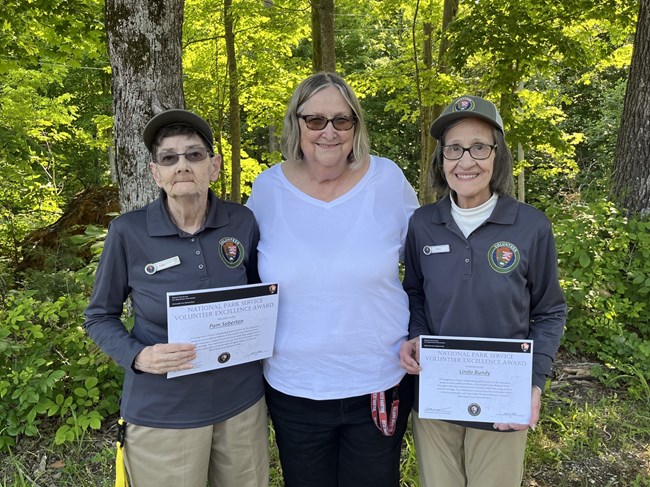
Pam Saberton and Linda Bundy
Mammoth Cave National Park
Region 1, 2, 4 – Southeast
Pam Saberton and Linda Bundy have dedicated more than 35 years as volunteers at Mammoth Cave National Park, traveling hundreds of miles each month to support the park's mission. Their work as curatorial assistants has greatly advanced the preservation and organization of the park’s cultural heritage. Linda has processed over 3,000 artifacts, while Pam has cataloged more than 350 items, ensuring their preservation for future generations.
Beyond their curatorial contributions, Pam and Linda have supported the Volunteer Program Office by coordinating enrichment activities, maintaining records, and assisting with volunteer onboarding. Pam also contributes remotely between visits, ensuring the program operates smoothly year-round. Their teamwork has improved documentation systems and fostered community engagement, connecting volunteers and visitors with the park’s mission.
Pam and Linda have also contributed to park restoration projects, including cave and cemetery restoration. Their research into the 1897 Mammoth Cave Hotel registry uncovered valuable historical narratives, further enhancing public engagement with the park. Through their dedication, Pam and Linda have strengthened partnerships with organizations like the National Speleological Society, ensuring Mammoth Cave’s legacy is preserved and shared with a global audience.
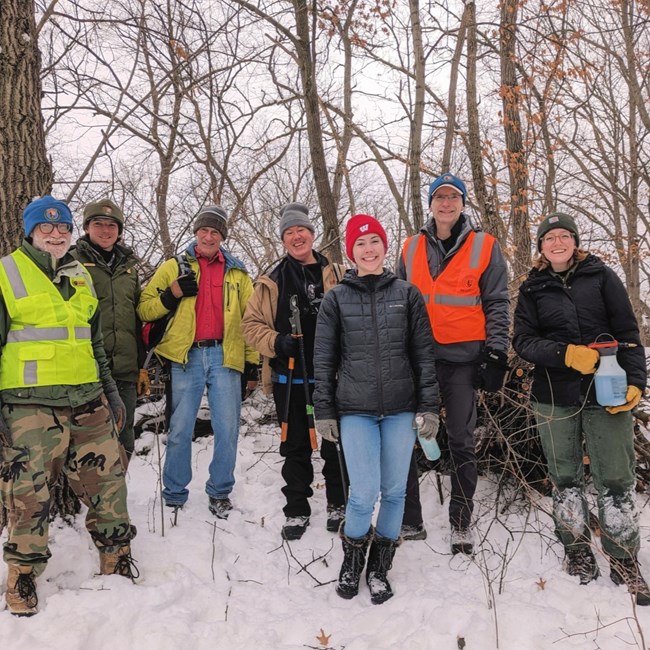
Coldwater Crew
Mississippi National River & Recreation Area
Region 3, 4, 5 – Midwest
The Coldwater Crew at the Mississippi National River and Recreation Area is a dedicated group of volunteers who have transformed the 29-acre Coldwater Spring site. In 2024, 20 crew members contributed over 1,400 hours to remove invasive species, plant natives, and maintain trails. They celebrated a major achievement: nearly all buckthorn was removed, with continued progress on nearby public lands.
The crew also supported 161 drop-in volunteers, guiding them through ecological restoration. Experienced members mentored newcomers, fostering a welcoming environment for all. Additionally, the crew acted as informal educators, sharing the site’s history with visitors.
The Coldwater Crew’s efforts enhance outdoor recreation and community engagement, ensuring safe access for visitors and contributing to projects like a prescribed burn and the B.A.R.K. Ranger program—a pet friendly education initiative that promotes responsible recreation with dogs on public lands. Their work with partners also led to the reintroduction of native orchids at the site, helping to advance restoration efforts.

Aspen Dendroglyph Survey Team
Valles Caldera National Preserve
Region 6, 7, 8 – Intermountain
The Aspen Dendroglyph Survey at Valles Caldera National Preserve documents historic tree carvings, or dendroglyphs, that date back to the late 1800s. These carvings, created by Hispanic sheepherders, are at risk of being lost due to wildfires, disease, and tree death. Since becoming a volunteer-led project in 2008, the survey team has recorded over 3,000 dendroglyphs across 35% of the park’s 89,000 acres.
Volunteers use predictive models to identify locations with high densities of glyphs, enabling more efficient surveys. This project has sparked community interest, with coverage in regional publications and programs at the Pajarito Environmental Education Center. In 2024, the survey team gained 4 new members, expanding its reach.
The team’s efforts have contributed to cultural resource preservation, helping trace ancestral connections for Hispanic families. The project also supports public education through guided hikes, StoryMaps, and media products, highlighting the cultural significance of the dendroglyphs. Partners, like PBS SciGirls, have brought additional exposure to the project, further connecting the community with the history embedded in these carvings.

Trails & Rails Coordinators
Klondike Gold Rush National Historical Park – Seattle Unit
Region 8, 9, 10, 12 – Pacific West
The Trails & Rails (T&R) coordinators at Klondike Gold Rush National Historical Park - Seattle Unit oversee 43 volunteers who provide interpretive services along the Coast Starlight and Empire Builder Amtrak routes. In 2024, the program reached 55,830 passengers, offering insights into the Pacific Northwest’s natural and cultural history. The coordinators manage schedules, provide training, and support volunteer development, empowering guides to take on leadership roles and update materials.
The coordinators also strengthen community ties, onboarding 15 new volunteers in 2024 and fostering partnerships with the Nisqually Tribe and Amtrak. Their outreach includes recruiting local volunteers through events in Pioneer Square and facilitating park staff exposure to the program, helping expand its impact.
In 2024, the program ran 329 onboard sessions and totaled 6,553 volunteer hours valued at $138,596. Positive passenger feedback highlights the program’s educational value. The coordinators' efforts contribute to the park’s mission by connecting diverse audiences to public lands and ensuring the program’s continued success and growth.

Wildlife & Safety Education
Denali National Park & Preserve
Region 1 – Alaska
The Wildlife Safety & Education group at Denali National Park enhances visitor safety and education in the Savage River area. Daily during the summer, 2 to 3 volunteers staff an information table, rove trails, and engage with visitors to minimize wildlife encounters, especially with grizzly bears. Their work improved compliance with wildlife closures and provided essential park orientation. In 2024, the team reached 26,000 visitors, educating them on how to safely hike in grizzly bear country and the importance of wildlife protection.
The volunteers also worked with park staff to improve communication and safety, using radios to quickly share wildlife sightings and safety information. Some volunteers participated in search and rescue training, ensuring readiness for emergencies. Their presence helped meet the park’s goals of education, recreation, and wildlife protection.
In 2024, when staffing was limited due to a park road closure, the group stepped in to manage a temporary contact station. By collaborating with park staff, the Wildlife Safety volunteers ensured a safer and more informative experience for visitors, strengthening the park's educational and safety efforts.
Excellence in Volunteer Management Staff Award
This award recognizes a National Park Service staff leader who has been strategic and/or innovative in managing a volunteer program
- Duration:
- 57.891 seconds
Sarah Corning, a volunteer program manager at Rocky Mountain National Park, is the recipient of the 2025 Excellence in Volunteer Management Staff Award.
National Recipient

Sarah Corning
Rocky Mountain National Park
Region 6, 7, 8 – Intermountain
In 2024, Sarah Corning made significant improvements to the volunteer program at Rocky Mountain National Park, focusing on safety, efficiency, and compliance. She introduced background checks, revamped uniforms, and clarified role descriptions, aligning volunteer positions with park policy. Sarah also streamlined the Job Hazard Analyses process by transitioning paperwork to Volunteer.gov, easing the administrative burden and allowing supervisors to focus on safety training.
Sarah successfully onboarded 113 new volunteers in 2024, in addition to over 300 returning volunteers. She provided essential resources like the park’s training library and kept volunteers engaged through weekly newsletters, ensuring they were informed about events, training opportunities, and safety protocols. This approach helped create a well-prepared, informed, and committed volunteer force.
Collaborating with the Rocky Mountain Conservancy, Sarah developed a group volunteer program that increased participation by 25% in 2024. This partnership also secured funding for additional staff to manage group events, ensuring the program's continued growth. Sarah's efforts strengthened the relationship with the Conservancy and supported the park’s mission to protect resources and engage the public.
Regional Recipients

Michael Perez-Robles +
Paterson Great Falls National Historical Park
Region 1 – Northeast
The staff at Paterson Great Falls National Historical Park, led by Park Guide Michael Perez-Robles, are nominated for excellence in volunteer management for their outstanding efforts this year. They successfully strengthened the volunteer program by aligning it with new guidelines, updating the volunteer handbook, and increasing volunteer engagement, including the recruitment of a 13-year-old who earned a Presidential Volunteer Service Award.
The Earth Day Clean-Up and Science Expo became a crucial resource for Paterson Public Schools, addressing the district’s teacher shortage and providing students with much-needed science education. Partners such as Paterson Public Schools, Passaic Valley Sewerage Commission, and others played key roles in recruiting volunteers, offering resources, and providing river updates.
With support from 15 content providers, the event engaged over 400 volunteers and students, offering educational activities on topics like conservation, space exploration, and geology. These efforts have significantly expanded the park’s educational impact and strengthened its community connections.

Kaley Crawford
Fort Sumter and Fort Moultrie National Historical Park
Region 1, 2, 4 – Southeast
Kaley Crawford has shown exceptional leadership in managing the Volunteers-In-Parks (VIP) program at Fort Sumter and Fort Mountrie National Historical Park, stepping in on short notice to make immediate improvements. She authored the first VIP Handbook and Policy and created a "Difficult Conversations Guide" to help staff and volunteers discuss sensitive topics. Her leadership in training, including a two-part series for 35+ VIPs, ensured program success and safety.
Kaley improved living history volunteer standards, ensuring alignment with National Park Service expectations, and maintained consistent communication with VIPs across four sites. She also utilized Volunteer.gov and collaborated with The Citadel to recruit college seniors for volunteer credit, strengthening the program and supplementing local volunteer efforts.
Her recruitment and retention strategies have been invaluable in Charleston’s challenging housing market. By engaging with The Citadel and Charleston County Public Libraries, Kaley boosted the park’s visibility, leading to a significant rise in library requests for ranger-led talks. Her efforts have enhanced the park's capacity to handle staffing shortages and reinforced a strong professional bond among staff and volunteers.

Michael Raymonds
Saint Croix National Scenic Riverway
Region 3, 4, 5 – Midwest
Michael Raymonds has played a pivotal role in strengthening the St. Croix National Scenic Riverway’s volunteer program, seamlessly blending policy and partnership. Since joining the Riverway in late 2023, Mike has contributed to staff training, created new volunteer opportunities, and designed a streamlined onboarding process with Wild Rivers Conservancy. His behind-the-scenes work with Volunteer.gov and close collaboration with the conservancy ensures the sustainability of the program as it continues to grow.
Mike's impact extends throughout the Riverway, from leading youth engagement activities to empowering volunteers of all ages across the 7,760-square-mile St. Croix Watershed. He turned a scout troop’s paddling trip into a stewardship experience and co-led a river cleanup connecting students to hands-on environmental action. His use of Volunteer.gov led to a 229% increase in adult volunteer recruitment, contributing to 5,894 volunteer hours in 2024.
In addition to recruiting and supporting volunteers, Mike's efforts in community outreach have been instrumental. His participation in over 60 community events, including major festivals and educational programs, has fostered public interest in the park. By leveraging volunteers and working closely with Wild Rivers Conservancy, Mike has strengthened the partnership and enhanced the Riverway’s ability to deliver educational and recreational programs, ensuring the park’s mission thrives.
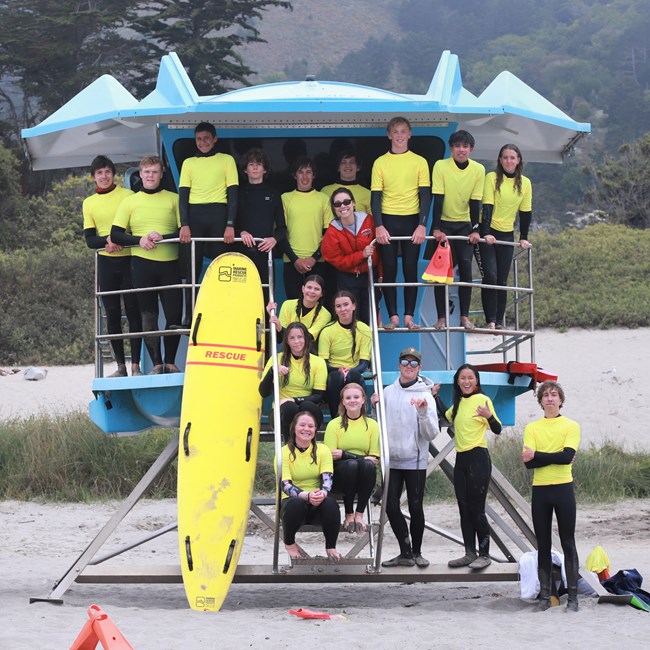
Malia Potter
Golden Gate National Recreation Area
Region 8, 9, 10, 12 – Pacific West
Malia Potter has been with the National Park Service since 2011, beginning as a Junior Lifeguard at Golden Gate National Recreation Area. She now serves as the program coordinator and lead instructor for the Junior Lifeguard program, overseeing its growth as the primary source of entry-level lifeguards. As an emergency services park ranger, Malia excels in training and managing both junior lifeguards and volunteers, ensuring the safety of park visitors.
In 2024, Malia successfully revamped the Junior Lifeguard program’s recruitment process by implementing a paperless system, improving efficiency. She collaborated with local schools and organizations to attract a diverse group of volunteers, with many of them becoming certified lifeguards. Malia's efforts resulted in the recruitment of several first-time volunteers, enhancing the park’s lifeguard staff.
Malia also partners with various agencies, such as the Stinson Beach Fire Department and the Coast Guard, to provide valuable training for her volunteers. These collaborations give junior lifeguards essential skills for ocean rescues and first responder tasks. Through her leadership, Malia has developed a robust pipeline of qualified lifeguards, ensuring visitor safety and fostering the growth of future ocean rescue professionals.
Tags
- channel islands national park
- delaware water gap national recreation area
- denali national park & preserve
- fort pulaski national monument
- fort sumter and fort moultrie national historical park
- golden gate national recreation area
- golden spike national historical park
- grand teton national park
- homestead national historical park
- klondike gold rush - seattle unit national historical park
- mammoth cave national park
- mississippi national river & recreation area
- moores creek national battlefield
- muir woods national monument
- national capital parks-east
- north country national scenic trail
- paterson great falls national historical park
- rocky mountain national park
- saint croix national scenic riverway
- san antonio missions national historical park
- santa monica mountains national recreation area
- upper delaware scenic & recreational river
- valles caldera national preserve
- washington-rochambeau revolutionary route national historic trail
- volunteers-in-parks
- excellence in volunteerism award
